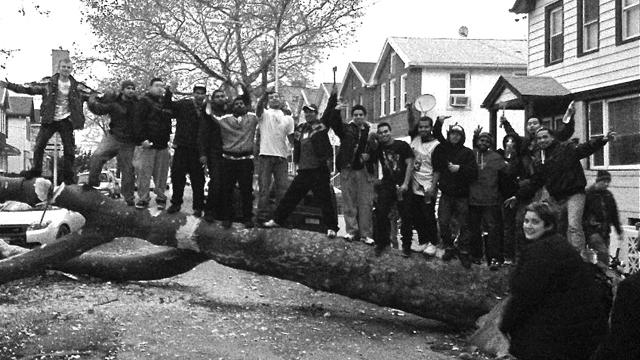
Photo: Hurricane Sandy survivors in Coney Island, Brooklyn. (Janna Powell/Occupy Sandy Relief NYC)
I’m not sure when I realized that we were in the middle of a full-blown disaster. Maybe it was when I saw the outline of a National Guard soldier hanging off the side of a hummer on a blackened strip of Rockaway Boulevard. Perhaps it was when I received a panicky email from an assemblyman’s office saying that “ppl are starving in Broad Channel.” I’m sure the comparisons to Hurricane Katrina and September 11 helped speed the realization. All I know for sure is that by Thursday, when widespread gas shortages swept New York City and out-of-staters began offering to donate bio-diesel trucks, I understood that we were organizing in the midst of a crisis.
Communication and travel in the affected areas has been difficult for lack of electricity and cell reception, but reports are nevertheless circulating among the network of volunteers who have mobilized since Tuesday morning, when Hurricane Sandy abated. There were stories of elderly women eating food out of dumpsters in still-blacked-out Lower Manhattan; a large ship cresting the median of a highway in Rockaway; the Red Cross aid station in the center of a desolate parking lot in Staten Island, guarded by NYPD barricades and serving only military rations; trick-or-treating through the pitch-black streets of Red Hook; the anxiety over running out of gas; kids navigating the former streets in a canoe; seniors stuck in their homes; families told to abandon their pets because the emergency shelters can’t accommodate animals. In some of these isolated pockets of the city, the logistical challenges are so daunting that federal authorities were just getting their feet on the ground as late as Thursday afternoon.
Meanwhile, a grassroots network of community-run relief stations and free kitchens has sprung up in the wake of Hurricane Sandy. The response began small and grew rapidly. On Monday there appeared an Occupy Sandy Relief Facebook page and the Recovers sites, set up by the environmental organization 350.org. Tuesday, a free kitchen opened at the Red Hook Initiative, a small nonprofit adjacent to a 5,000-person public housing complex without electricity. Wednesday, another kitchen was up and running in Rockaway Beach, much of which was on fire. During a Thursday evening conference call, it took an hour simply to list the number of drop-off locations, distribution sites and on-the-ground relief stations that spanned at least four of the boroughs, all coordinated by the InterOccupy network. Thousands of volunteers clamored to be put to work; donations were pouring in. The almost unwieldy expansion was similar to the early days of Zuccotti Park: spontaneous, decentralized and, for many, all-consuming. Few outside the network, however, understood that this relief was in itself an act of resistance.
Storms receive a very different kind of response from society and from government officials than other types of crises — especially in a major urban center like New York City. The police and firefighters suddenly take interest in people’s material needs; the Red Cross and FEMA, the Federal Emergency Management Agency, deploy millions of dollars and thousands of workers in efforts to alleviate the devastation. Officials yank on boots and call press conferences where they’ll say almost anything; Mayor Bloomberg went so far as to endorse Obama, words of support that the campaigning president welcomed with gratitude.
Unlike poverty, homelessness, hunger, displacement and other untenable living situations, weather-wrought devastation mobilizes public sympathy and government action because it is a “natural” disaster. This delineation is, of course, mostly a myth in the era of accelerating climate change. But it’s one society clings to anyway, because to recognize natural disasters as the natural outcomes of human capitalism would be even more disruptive than the storm itself.
For organizers, however, disaster relief and political protest are two tactics toward a common goal: stopping large-scale human suffering incentivized by global economic forces. After all, as a former volunteer at occupied Zuccotti Park recently reminded me, Occupy itself was also born out of a deadly and lucrative crisis.
I first learned this lesson from members of Occupy Homes Minneapolis, many of whom had been first responders after a tornado sliced through an area of North Minneapolis in May 2011. The storm knocked down chimneys, damaged roofs and sculpted trees into gigantic bonsais. A year later, as many of the same organizers focused on saving the area from the undeniably human-created foreclosure crisis, it was almost impossible to distinguish between the blocks that were hit by the tornado and those plagued by displacement. The boarded-up doors, the kicked-in cellar windows and neglected roofs were all the same. Aside from the intact trees, there were only two major differences. One was architectural: The tornado-stricken blocks were mostly filled with Tudor homes, while the foreclosed homes were, conveniently, more often 1940s Colonials with aluminum siding and copper wires that made them especially enticing for scrappers. The second was sentimental: The broader public had sympathy for the victims of the tornado, while, only one year later, the majority still held foreclosed-upon families responsible for the collective crisis that ended up claiming these families’ homes.
Hurricane Sandy wreaked devastation on thousands of New Yorkers, and temporary inconvenience on millions more. Meanwhile, nonprofits, churches, neighborhood groups and community organizers have been lending and continue to lend everything from a day’s work to a chainsaw to bike-powered electricity — a show of community care that many are talking about as the spirit of New Yorkers. The question remains, however, what will happen to this spirit when the effects of this storm abate, leaving us again to the mercy of a world that incentivizes suffering. At the very least, an even stronger relief network will be in place to weather the next surge.
3 WAYS TO SHOW YOUR SUPPORT
- Log in to post comments













